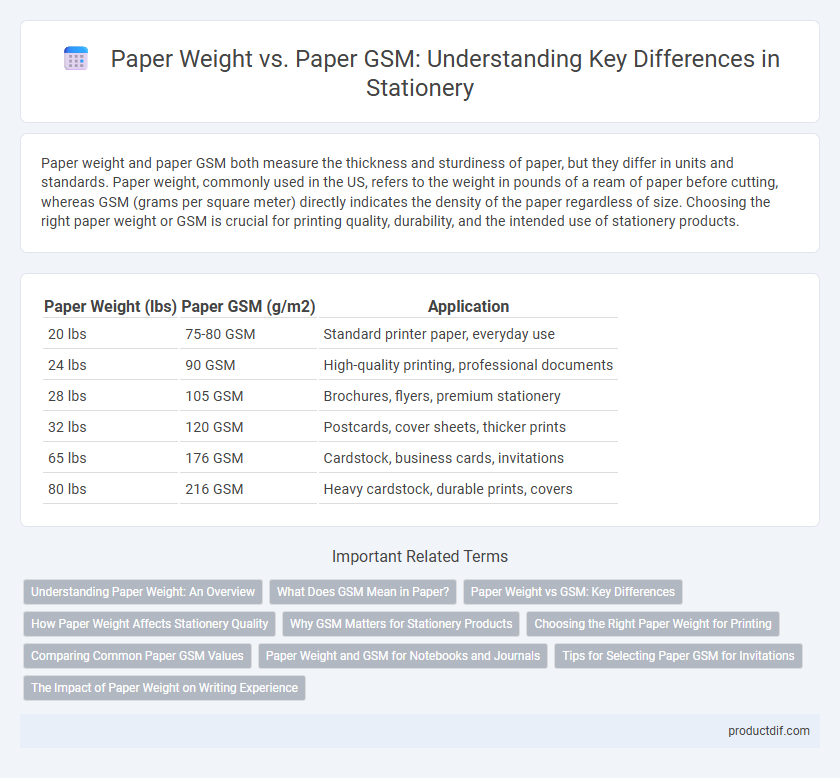Paper weight and paper GSM both measure the thickness and sturdiness of paper, but they differ in units and standards. Paper weight, commonly used in the US, refers to the weight in pounds of a ream of paper before cutting, whereas GSM (grams per square meter) directly indicates the density of the paper regardless of size. Choosing the right paper weight or GSM is crucial for printing quality, durability, and the intended use of stationery products.
Table of Comparison
| Paper Weight (lbs) | Paper GSM (g/m2) | Application |
|---|---|---|
| 20 lbs | 75-80 GSM | Standard printer paper, everyday use |
| 24 lbs | 90 GSM | High-quality printing, professional documents |
| 28 lbs | 105 GSM | Brochures, flyers, premium stationery |
| 32 lbs | 120 GSM | Postcards, cover sheets, thicker prints |
| 65 lbs | 176 GSM | Cardstock, business cards, invitations |
| 80 lbs | 216 GSM | Heavy cardstock, durable prints, covers |
Understanding Paper Weight: An Overview
Paper weight and GSM are measures that indicate the thickness and density of paper, influencing its durability and suitability for various applications. Paper weight, often measured in pounds (lbs), refers to the weight of a ream (usually 500 sheets) of paper in its basic size, while GSM (grams per square meter) quantifies the mass of paper based on its area, offering a universal standard. Understanding paper weight helps identify the paper's strength and quality, crucial for printing, crafting, and professional stationary uses.
What Does GSM Mean in Paper?
GSM, or grams per square meter, is a metric measurement that defines the weight of paper relative to its size, indicating its density and thickness. Paper weight measured in GSM helps determine the durability and quality, with higher GSM values representing heavier, thicker sheets ideal for professional printing or crafting. Understanding GSM allows consumers and manufacturers to select the appropriate paper type based on specific printing, writing, or packaging needs.
Paper Weight vs GSM: Key Differences
Paper weight and paper GSM both measure the thickness and density of paper but differ in regional usage and calculation methods. Paper weight is primarily used in North America and refers to the weight of a ream of paper in pounds, while GSM (grams per square meter) is an international standard measuring the mass of paper per square meter. Understanding the differences between paper weight and GSM helps in selecting the appropriate paper for printing, packaging, or crafting based on thickness, durability, and finish requirements.
How Paper Weight Affects Stationery Quality
Paper weight significantly influences stationery quality by determining durability, thickness, and overall feel, directly impacting user experience and print performance. Higher paper GSM (grams per square meter) indicates thicker, sturdier paper, suitable for premium stationery like business cards, invitations, and letterheads, ensuring resistance to tearing and ink bleed. Conversely, lower GSM paper is lighter and more flexible, ideal for everyday use such as notepads and flyers but may compromise longevity and perceived professionalism.
Why GSM Matters for Stationery Products
Paper GSM (grams per square meter) is a critical factor in stationery as it directly influences the thickness, durability, and overall quality of paper products. Higher GSM paper provides sturdiness essential for premium notebooks, business cards, and invitations, ensuring a professional finish and resistance to tearing. Selecting the appropriate GSM enhances user experience by aligning the paper's weight with its intended purpose, from lightweight printing to heavyweight cardstock applications.
Choosing the Right Paper Weight for Printing
Paper weight and paper GSM both indicate the thickness and quality of paper, essential for selecting the appropriate material for printing projects. Paper weight, commonly measured in pounds (lbs) in the United States, refers to the weight of a ream of paper, while GSM (grams per square meter) is an international standard that measures paper density. Choosing the right paper weight or GSM ensures durability, print clarity, and professional appearance, with heavier paper typically preferred for business cards and brochures, and lighter paper suited for everyday printing and flyers.
Comparing Common Paper GSM Values
Paper weight and paper GSM (grams per square meter) both indicate thickness, but GSM is a standardized metric widely used internationally. Common paper GSM values range from 70 to 120 for typical office papers, with 80 GSM representing standard printer paper and 120 GSM often chosen for higher quality prints or brochures. Heavier paper like 160 GSM and above is preferred for durable stationery such as business cards and invitations.
Paper Weight and GSM for Notebooks and Journals
Paper weight and GSM (grams per square meter) are critical factors influencing the quality and durability of notebooks and journals. Higher GSM values, typically ranging from 70 to 120 GSM in notebooks, indicate thicker and more opaque paper, reducing ink bleed and enhancing writing comfort. Paper weight, often measured in pounds (lbs) in the US, correlates with GSM, allowing consumers to choose notebooks suited for specific uses such as sketching, note-taking, or archival quality.
Tips for Selecting Paper GSM for Invitations
When selecting paper GSM for invitations, consider that higher GSM values indicate thicker, more durable paper, typically ranging from 200 to 300 GSM for a premium feel. Lighter GSM paper, such as 90 to 150, is suitable for RSVP cards or inserts, balancing elegance and flexibility. Prioritize GSM that complements the invitation's design and mailing requirements to ensure both tactile quality and practical delivery.
The Impact of Paper Weight on Writing Experience
Paper weight, measured in pounds (lbs) in the US and grams per square meter (GSM) internationally, significantly influences the writing experience by affecting texture, thickness, and durability. Heavier paper weights, such as 90 GSM and above, provide a smoother surface ideal for fountain pens and reduce ink bleed-through, enhancing legibility and overall comfort. Lighter papers below 80 GSM tend to be thinner and more prone to feathering, which can deteriorate handwriting quality and create a less satisfying tactile feel.
Paper Weight vs Paper GSM Infographic

 productdif.com
productdif.com